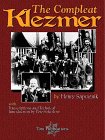by Henry Sapoznik
with transcriptions and technical introduction
by Pete Sokolow
Tara Publications
Cedarhurst, N.Y., 1987

I remember my bar mitzvah.
My parents had hired one of the top New York City klezmer clarinetists to play at the reception. So there he was on the bandstand blowing some of the best bulgars in the business and all I wanted to do was to crawl into the nearest, deepest hole.
"Can't this guy play anything modern?" the bar mitzvah kvetshed. At that point all my life had been spent in the presence of this kind of music. I made no distinction between the Hasidic niggunim we sang on the schoolbus going to Lubavitch yeshiva or the klezmer and Yiddish music ubiquitously heard at the Catskill hotels where we sang during Passover. I thought everybody had a cantor father who wandered around the house softly humming the High Holiday liturgy to himself. It was all the same to me.
And I wanted to have done with it.
I actually wanted to be a normal kid (Beaver Cleaver would do...) who didn't go to yeshiva, sing in a choir or have to shlep to the mountains every spring. He was playing klezmer and I wanted to rock'n'roll.
But something's changed.
In the last decade, klezmer music, this traditional instrumental music of the Jews of Eastern Europe, has attracted a robust reinterest in the American Jewish community. From Sheepsheed Bay to Seattle, new klezmer musicians are appearing and older ones reappearing. Growing audiences across the country are made up of old folks who are reminded of their younger days and younger folks for whom these will some day have been the old days.
The music was patiently waiting for us to hear it again.
---
After my bar mitzvah my interest in Jewish music was also at an all time low. I left yeshiva and entered a new record. After playing rock'n'roll, I eventually drifted into the folk songs of Woody Guthrie, Cisco Houston and Bob Dylan. I soon found myself getting into more traditional kinds of music: Irish, New England Contradances, but mainly Appalachian string band music.
In the summer of 1973, I went with a few friends down to Surry Co., North Carolina. We went to visit with and learn from Tommy Jarrell, a 73 year old master of traditional America music. On my third visit to Mt. Airy (birthplace of Andy Griffith and model for TV's "Mayberry") Tommy asked me something. He had always known that there was an extraordinarily high percentage of young Jews playing old time music. He didn't understand it; but he accepted it. One day he asked me in all candor:
"Hank, donít your people got none of your own music?"
For more info visit Living Traditions